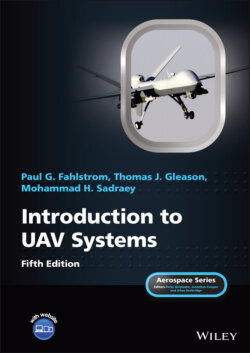Читать книгу Introduction to UAV Systems - Mohammad H. Sadraey - Страница 54
2.2.2 Classification by Range and Endurance
ОглавлениеShortly after being appointed the central manager of US military UAV programs, the Joint UAV Program Office (JPO) defined classes of UAVs as a step toward providing some measure of standardization to UAV terminology. They were:
Very Low‐Cost, Close‐Range: Required by the Marine Corps and perhaps the Army to have a range of about 5 km (3 miles) and cost about $10,000 per air vehicle. This UAV system fits into what could be called the “model airplane” type of system and its feasibility with regard to both performance and cost had not been proven but since has been demonstrated by systems such as the Raven and Dragon Eye.
Close Range: Required by all of the services but its concept of operation varied greatly depending on the service. The Air Force usage would be in the role of airfield damage assessment and would operate over its own airfields. The Army and Marine Corps would use it to look over the next hill, and desired a system that was easy to move and operate on the battlefield. The Navy wanted it to operate from small ships such as frigates. It was to have a range of 50 km (31 miles), with 30 km (19 miles) forward of the FLOT. The required endurance was from 1 to 6 h depending on the mission. All services agreed that the priority mission was reconnaissance and surveillance, day and night.
Short Range: The Short‐Range UAV was also required by all of the services and, like the Close‐Range UAV, had the day/night, reconnaissance, and surveillance mission as a top priority. It had a required range of 150 km (93 miles) beyond the FLOT, but 300 km (186 miles) was desired. The endurance time was to be 8–12 h. The Navy required the system to be capable of launch and recovery from larger ships of the Amphibious Assault Ship and Battleship class.
Mid‐Range: The Mid‐Range UAV was required by all the services except the Army. It required the capability of being ground or air launched and was not required to loiter. The latter requirement suggested that the air vehicle was a high‐speed deep penetrator and, in fact, the velocity requirement was high subsonic. The radius of action was 650 km (404 miles) and it was to be used for day/night reconnaissance and surveillance. A secondary mission for the mid‐Range was the gathering of meteorological data.
Endurance: The Endurance UAV was required by all services and, as the name suggested, was to have a loiter capability of at least 36 h. The air vehicle had to be able to operate from land or sea and have a radius of action of approximately 300 km (186 miles). The mission was day/night reconnaissance first and communications relay second. Speed was not specified, but it had to be able to maintain station in the high winds that would be experienced at high altitudes. The altitude requirement was not specified, but it was thought probably to be 30,000 ft (9.14 km) or higher.
Long range: This class of UAVs was not defined by JPO. However, an endurance UAV is capable of flying in a long range (e.g., thousands of miles) mission.
This classification system has been superseded. However, some of the terminology and concepts, particularly the use of a mix of range and mission to define a class of UAVs, persist today and it is useful for anyone working in the field to have a general knowledge of the terminology that has become part of the jargon of the UAV community.
The following sections outline some of the more recent terminology used to classify UAVs. Any government‐dictated classification scheme is likely to change over time to meet the changing needs of program managers, and the reader is advised to search the literature and other references if the current standard of government classification is needed. Operation and certification of small unmanned aircraft systems is regulated [5] by Federal Aviation Administration under Part 107.
